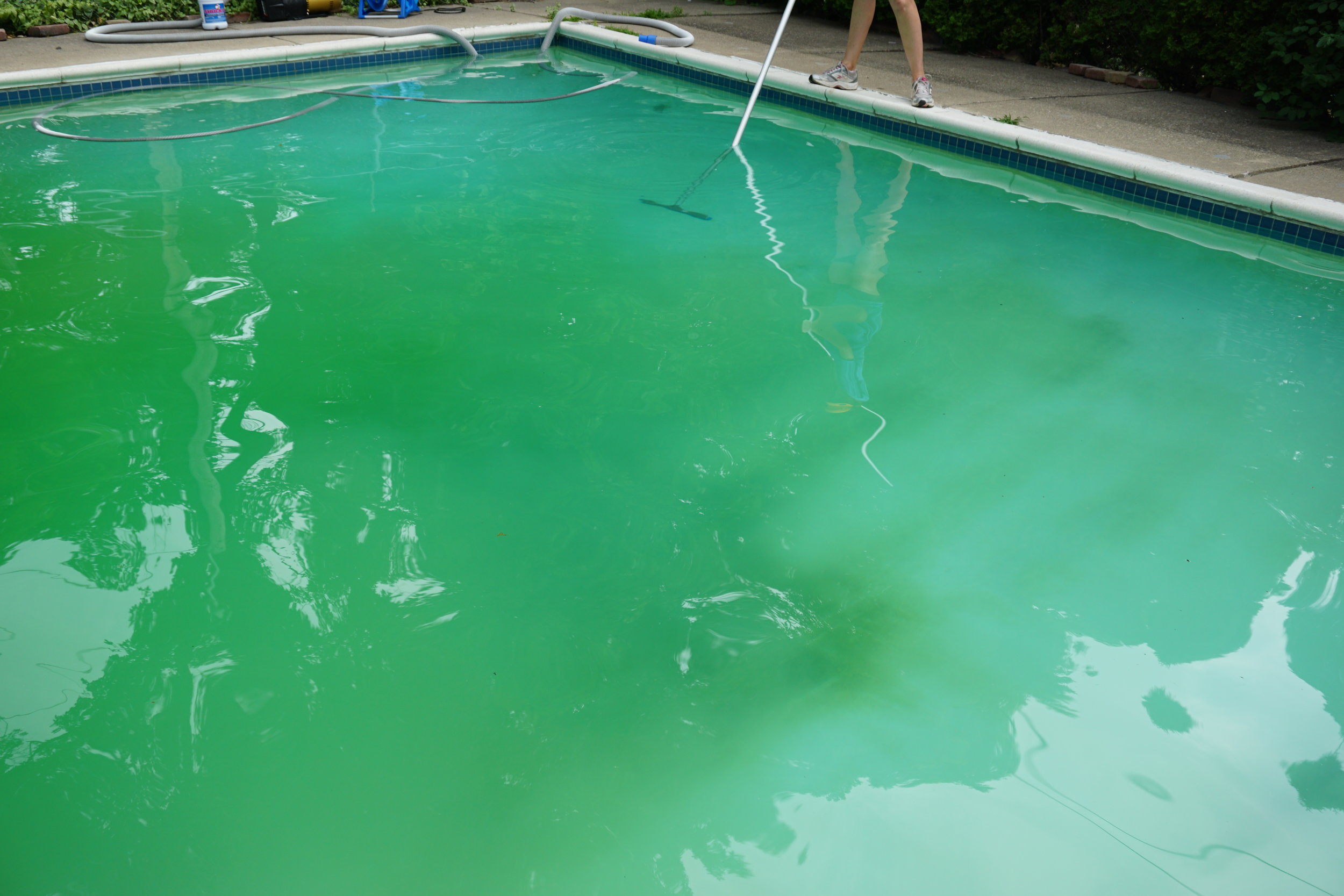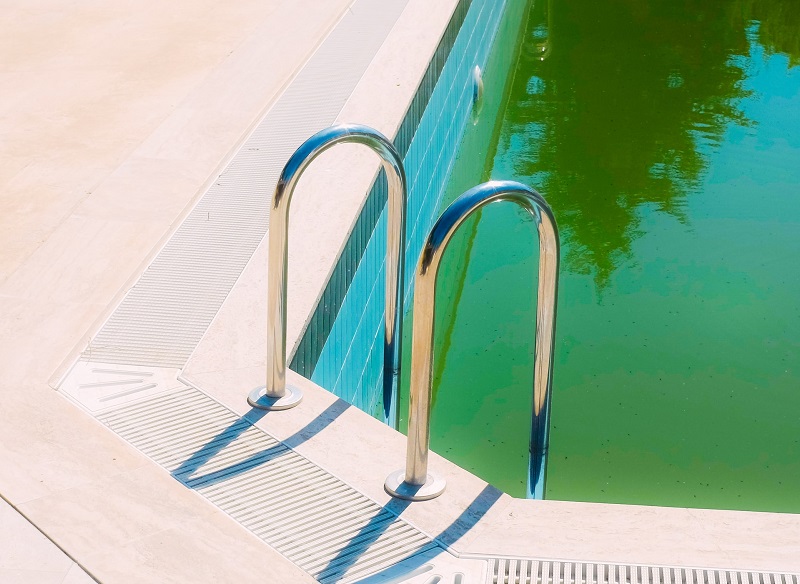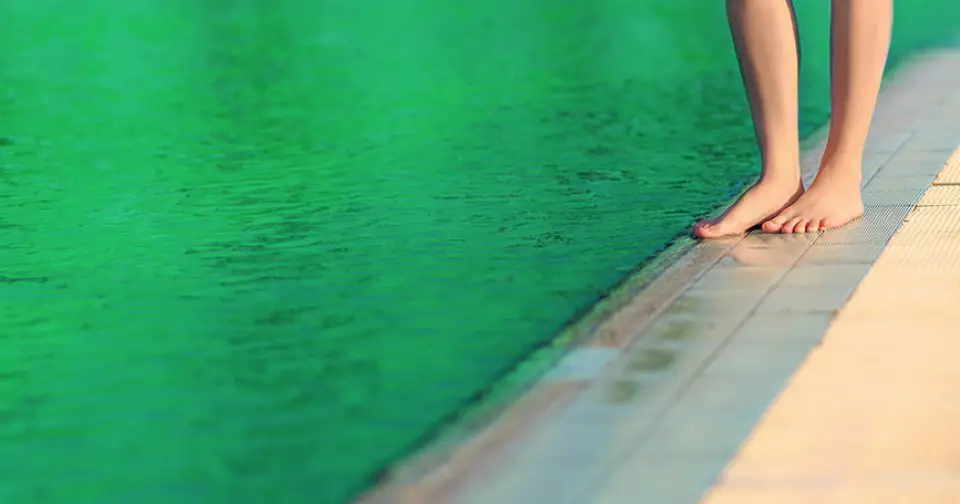Good advice for pool care is preventative maintenance and it doesn’t have to be complicated. If you know how and why algae grow in your pool then you can head it off at the pass so to speak before it gets out of hand but sometimes you have to think outside the box. How can Algae grow in a Pool even though the Chlorine is High?
- Poor H2O circulation; low flow or dead spots in the pool
- Poor H2O balance; pH, Alkalinity, Calcium
- High Cyanuric levels
- Poor H2O sanitation; low or inconsistent free chlorine (FC) levels
- Poor H2O filtration; short filter run times or an ineffective filter
- Warm H2O
- Sunspots
- High levels of phosphates
Introduction:
Algae are always present in swimming pools, even clean and blue pools, and contain algae at the microscopic size. It hides patiently for the opportunity to bloom when the chlorine level dips and the pH rises or the pump or filter is not operating effectively among other scenarios BOOM!
Algae in Pool but Chlorine is High
Your swimming pool turned green but your chlorine residual is high. Everything you understand about chlorine and algae is thrown out the window. The mystery answer is that the stabilizer (CYA) available in the chlorine product can buffer the effect of Chlorine. Is your pool Balanced?
One of the most overlooked reasons for this to happen. The CYA will protect the chlorine from being used all at one time which will defeat the purpose of super-chlorinating.

Having algae in a pool despite high chlorine levels can be indicative of several issues. Here are steps you can take to address the problem:
- Test Water Chemistry: Use a reliable pool water testing kit to check the pH, chlorine levels, alkalinity, and calcium hardness. Sometimes, despite high chlorine levels, other factors like pH imbalance or inadequate circulation can contribute to algae growth.
- Adjust pH Levels: Ensure that the pH level of the pool water is within the optimal range (usually between 7.2 and 7.6). If the pH is too high, it can reduce the effectiveness of chlorine.
- Shock Treatment: Perform a shock treatment to raise the chlorine level significantly higher than normal to kill algae and other contaminants. Follow the manufacturer’s instructions for the shock treatment product you’re using.
- Brush and Vacuum: Brush the pool walls and floor to loosen algae and vacuum the pool to remove dead algae and debris. This step helps to physically remove algae from the pool.
- Ensure Proper Circulation and Filtration: Ensure the pool pump and filter run effectively to circulate water and remove debris. Poor circulation can create areas where algae can thrive.
- Algaecide Treatment: Consider using an algaecide to prevent further algae growth. Choose an algaecide that is suitable for your pool type and follow the instructions carefully.
- Maintain Chlorine Levels: After shocking the pool, monitor chlorine levels regularly and maintain them within the recommended range for your pool type. Consistent chlorine levels help to prevent algae growth.
- Address Sunlight Exposure: Algae growth can be exacerbated by direct sunlight. Consider using a pool cover when the pool is not in use to reduce sunlight exposure.
- Regular Maintenance: Establish a routine maintenance schedule that includes regular cleaning, testing, and chemical balancing to prevent algae growth in the future.
By following these steps and addressing any underlying issues contributing to algae growth, you can effectively eliminate algae from your pool and prevent its recurrence. If the problem persists despite your efforts, you may need to seek advice from a professional pool service technician.
High Cyanuric Acid and Phosphate Levels
Cyanuric acid, or CYA as it is commonly called (and also called pool stabilizer, pool conditioner, or chlorine stabilizer), acts as that buffer, protecting your chlorine from those hungry UV rays. You can get it in liquid or granule form, or mixed with chlorine tablets or sticks ( trichlor) and in chlorine shock (dichloro).
As a result, you must ensure you properly check and adjust the levels of sanitizer in your pool. The ideal range is between 80 and 120 parts per million. If too high cyanuric acid level and it’s above that, you need to partially drain the pool and then add more water this will dilute it.
This is true unless they are maintained together in the proper ratio. Super-chlorinating the green pool water to bring up the free chlorine levels to high levels over 10ppm can correct the situation and balance and kill the green algae in the swimming pool water.
High levels of cyanuric acid (CYA) and phosphates in a pool can contribute to various issues, including algae growth and reduced effectiveness of chlorine. Here’s how you can address each of these issues:
Cyanuric Acid (CYA) Levels:

- Dilution: If CYA levels are extremely high, partially draining and refilling the pool with fresh water can help dilute the concentration of CYA.
- Limit CYA Use: Use pool products with little to no CYA content to avoid further increasing levels. Non-stabilized chlorine products like liquid chlorine or calcium hypochlorite can be used.
- Alternative Sanitizers: Consider alternative pool sanitizers that do not contain cyanuric acid, such as bromine. However, switching sanitizers may require adjustments to other aspects of pool chemistry.
- Regular Testing: Continuously monitor CYA levels to prevent them from reaching excessive levels in the future. Regular testing allows for timely intervention before levels become problematic.
Phosphate Levels:
- Phosphate Remover: Use a phosphate remover to reduce phosphate levels in the pool. Phosphate removers work by binding with phosphates, making them easier to filter out of the water.
- Manual Removal: Vacuum the pool to remove any organic debris that may contribute to phosphate levels. Organic matter serves as a food source for algae, and reducing it can help prevent algae growth.
- Maintain Filtration: Ensure that the pool filtration system is functioning optimally to effectively remove phosphates and other contaminants from the water.
- Limit Organic Matter: Minimize the introduction of organic matter into the pool by regularly skimming the surface, trimming vegetation near the pool, and discouraging activities that introduce organic debris.
- Regular Maintenance: Implement a regular pool maintenance schedule that includes brushing, skimming, and backwashing the filter to prevent the buildup of organic matter and phosphates.
- Address Sources of Phosphates: Identify and address any sources of phosphates around the pool area, such as fertilizers, plant debris, or nearby bodies of water that may introduce phosphates into the pool.
- Test Water Quality: Periodically test the water for phosphate levels and take appropriate action if levels rise above recommended thresholds.
By addressing both cyanuric acid and phosphate levels in the pool and implementing measures to prevent their buildup in the future, you can improve water quality and reduce the risk of algae growth and other issues. Regular maintenance and monitoring are key to maintaining balanced pool chemistry. If you’re unsure about how to proceed, consulting with a professional pool technician or water treatment specialist can provide valuable guidance.
The reason the pool turned green in the first place was that the Free Chlorine levels slipped down below the proper levels for preventing the algae from starting.
What’s the answer Chlorine-Keep the chlorine levels high and consistent! High doses of chlorine usually quickly kill the algae when the levels are properly balanced indicating a low-level algae. Keeping a well-balanced pool is how to get rid of algae quickly.
High pH High Phosphate High Chlorine Levels
There are a few reasons why your chlorine is not killing the algae in your pool.
- High pH: Chlorine does not work well in water with a high pH. The recommended pH range for chlorine to sanitize effectively is between 7.2 and 7.8. In waters that have a higher pH than this, chlorine can lose up to 90% of its effectiveness. As a result of this, algae can grow unaffected. Though you might be shocking your pool and sanitizing it routinely, your pool will still remain cloudy with algae. In general, high pH encourages the growth of algae.
- High phosphate levels: Phosphates are food for algae. This means that though you might be sanitizing your pool if the phosphate levels are high, the algae will keep being fueled. They continue to bloom because they are getting nutrients. It is essential to reduce your phosphate levels so the algae are starved, and then your chlorine works more effectively.
- Or bring your FC-free chlorine levels up to par and there won’t be any microbes (Algae) to feed.
- Chlorine lock: A chlorine lock is a situation whereby, despite adding more chlorine, the chlorine in your pool is still rendered useless. This situation can come about when there is excess cyanuric acid in your pool.
- Cyanuric acid is what forms pool stabilizers that you use to extend the lifespan of chlorine in your pool from tablets or granular chlorine. However, this stabilizer can have drawbacks when used in excess.
Does Adding Chlorine Kill Algae in Pool Water
Yes!
Here is the thing. Test for Free Chlorine (FC) Having high total chlorine with low free chlorine makes your pool a perfect home for algae and other microbes in pool water. What kills algae in your pool is the available free chlorine.
If you notice that the chlorine in your pool is no longer effective, it could be a result of low free chlorine in the pool, which will require a shock. It could also be a result of the chlorine lock caused by the stabilizer in the pool or an unbalanced swimming pool.
If you are experiencing green water or an algae outbreak, you have to increase your free chlorine concentration to a breakpoint of over 30 parts per million. The severity of the algae growth will also determine how much shock you will use.
For light green pools, you can administer 1 pound of pool shock for every 10,000 gallons of pool water and run the pool filter. For a very dark green pool, you might have to use up to 3 pounds of shock per 10,000 gallons of pool water.
-
-
How to Fix Cloudy Green Pool Water
Cyanuric Acid Levels
If you’re using chlorine pucks in the pool water or stabilized pool chlorine, there’s a chance that you have excess cyanuric acid levels in your pool. Keeping your cyanuric acid levels at the recommended levels is a balancing act (pun intended) on its own.
Too low a cyanuric acid level will also lead to your chlorine being burned away by the UV rays of the sun, but too high of a cyanuric acid level will make your chlorine ineffective, causing green pool H2O even if you have chlorine residual in your pool.
pH Levels-Does Algae like high or low pH
Another reason for getting green pool water, even if you have great pool chlorine residual levels, is having a high pH level. High pH levels, much like high cyanuric acid levels, can make your pool chlorine ineffective and algae are growing in the pool water or spa.
You can get away with a pH level of 8.0, but the higher it goes from there, the more ineffective your pool chlorine will be. This is fairly important to note especially if you’re using a saltwater chlorinator since saltwater chlorination typically drives pool water to higher pH levels than traditional chlorination with liquid or granulated chlorine.
Phosphate Level
Phosphates are not something that is commonly tested (or included) in many pool water test kits. Even if you have the right free chlorine levels, having a high phosphate level can still lead to green pool water.
Phosphates in pools are what we consider an algae superfood, so even if you have the proper pool chlorine levels, you can still end up with green pool water. Phosphates naturally come from organic pool debris, rain, and runoff from your lawn and sometimes pool cleaners.
-
How do you lower Combined Chlorine?
When you measure the water in your swimming pool, the amount of combined chlorine in the water should be less than 0.5 PPM. If the numbers are higher, the pool may need to be shocked to get rid of the odor..……………………………..read more
Algae on Pool Walls
Another form of Algae growing in swimming pool water is when the chlorine is reading high but algae grow on the walls or the floor in streaks. If you’re not sure if there are algae in your pool, you can do a simple visual inspection to determine if it is present.

The most common pool algae will be a greenish hue and will be slimy to the touch. Pool water algae can also be black, mustard, or additional colors.
Normally these types of algae on pool walls are easy to remove because they are loose. In chlorine or bromine pools, algae grow when free chlorine is low, and or pH has drifted. In a salt-water pool, algae can get a foothold if the salt level is low or if the system has a hiccup. Free available pool Chlorine indicates a low level of algae.
Large algae attached to walls or the floor prefer hot weather and stagnant water, so if your pool goes unused for some time during the summer, you may come back to find an algae invasion in streaks. Algae growing on the walls or bottom of your pool is due to:
- Poor pool water circulation
- Not enough sanitizer in pools
- Poor pool water filtration
- Poor water balance levels
- Use a good reliable test kit and check the levels
- Shock the pool with good chemicals
- Brush the walls and floor of the pool-sweep gently towards the pool’s center-
- Vacuum-then filter pool water
*Keep in mind that the hot sun spots in the pool will burn off the effective chlorine in the water, so while you may think you’re putting in the right amount of pool chemicals, adding chlorine to stay in balance but your pool’s composition may have slipped below the critical point, especially in areas of a pool.
I had a huge pool exposed to the sun and ran the filter at night to save money at a lower rate. Run the filter for an hour or so when the sun is at its highest in the afternoon, especially in the heat of summer.
*Occasionally, I dealt with streaks of algae in the deep ends of my pool. Not because of an imbalance in pool water chemistry but because of circulation problems and heat.
Conclusion:
Algae are always present in swimming pools, even clean and blue pools, and contain some algae at the microscopic size.
- Poor H2O circulation; low flow or dead spots in the pool
- Poor H2O balance; pH, Alkalinity, Calcium
- High Cyanuric levels
- Poor H2O sanitation; low or inconsistent free chlorine (FC) levels
- Poor H2O filtration; short filter run times or an ineffective filter
- Warm H2O
- Sunspots
- High levels of phosphates
It hides patiently for the opportunity to bloom when the chlorine level dips and the pH rises or the pump or filter is not operating effectively among other scenarios.
Combined Chlorine is the portion of chlorine in the water that has reacted and combined with ammonia, such as nitrogen-containing contaminants, and other organics that come from a swimmer’s perspiration, urine,…………………………………read more

References:
St. CYR Pools and Spa-Get Rid Of Algae In a Pool – 4 Keys To An Algae-Free Pool
FAQ’s
- Why is my pool water cloudy? Cloudy pool water can be caused by various factors, including inadequate filtration, unbalanced pH levels, high levels of dissolved solids, or algae growth. Testing the water and addressing any imbalances or issues with filtration can help clear up cloudy water.
- How often should I test my pool water? It’s recommended to test pool water at least once a week, especially during the swimming season. However, testing after heavy rainfall, significant pool usage, or when you notice any water quality issues is also advisable.
- What is the ideal pH level for pool water? The ideal pH level for pool water is typically between 7.2 and 7.6. Maintaining pH within this range ensures the effectiveness of chlorine and prevents irritation to swimmers’ eyes and skin.
- How can I lower the pH in my pool? To lower pH, you can use pH decrease (sodium bisulfate) according to the manufacturer’s instructions. Additionally, adding muriatic acid or diluting the pool water with fresh water can help lower pH levels.
- Why does my pool water have a strong chlorine smell? A strong chlorine smell in pool water is often an indication of chloramines, which are formed when chlorine combines with organic matter like sweat and urine. Shocking the pool, maintaining proper chlorine levels, and improving circulation and filtration can help reduce chloramines.
- How do I prevent algae growth in my pool? Preventing algae growth involves maintaining proper water balance, including pH and chlorine levels, as well as regular brushing, vacuuming, and circulation. Using an algaecide and keeping debris out of the pool can also help prevent algae.

